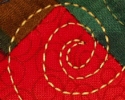Do you really HAVE to stitch in the ditch?
 What would you like the answer to be? (grin)
What would you like the answer to be? (grin)
Quilters can make a case for both a “yes” and a “no” answer. By quilting very closely to the seam allowances, you can “simulate” stitching in the ditch when the quilt is viewed from a distance. However, if excess fabric causes the seam line to wobble as you quilt near it and then move away again, you are doing more harm than good (at least visually or as far as a quilt judge may be concerned).
Of course, quilts that are truly quilted “edge to edge” will not have stitching in the ditch. These quilting lines pass over the seams many times and are designed to blend the quilt’s elements together. But if you choose to highlight areas of the quilt with custom quilting, your decision to stitch the ditch or leave it alone should be made based on whether any seam lines must maintain a straight visual appearance.
Borders and sashing strips should look very straight; after all, the border serves as a frame to the quilt and gives it that “finished” look. Stitching in the ditch between borders helps stabilize the fabric, maintaining straight lines and preventing distortion. If you choose to stitch the ditch, do it as the first step before adding any quilting design in the border or sashing. If you are adding extra background quilting around your design, that would be the last element to add to the quilt.
“But it’s too hard!” is a lament uttered often by quilters. If your daughter said that about her piano recital piece, what would you say? “The more you practice, the easier it gets!” If you are timid about stitching in the ditch, you’ll never develop your confidence by standing on the sidelines.
Practice your technique, using an expanded base on your machine for support, and a guiding ruler with grippies on the underside. Try holding the ruler so that your thumb and pointer finger (on either hand) are aimed toward the needle. Keep the needle between your thumb and fingertip. If the ruler is longer than that span, “walk” your hand down the ruler as you move the machine, just as you would a rotary cutting ruler.
Hold the ruler on the “low side” of the seam whenever possible. Practice holding the ruler with either hand, driving the machine with the opposite hand. With a stitch-regulated machine, you can drive the machine with either the right or left handle. If you are still timid, try using invisible thread in the machine for stitching in the ditch (it’s very forgiving to both learning quilters and experienced quilters!)
Stitch Regulators are NOT created equally.
You put your heart and soul into every creation, choosing fabrics and patterns like a painter’s palette. When you invest so much of yourself in your quilting passion, you deserve quilting stitches that are just as beautiful as the quilt top you’ve conceived.
A quality stitch regulator should allow you to place every quilting stitch exactly where you want it. Whether you’re zooming over your quilt adding your own flair with stars and loops, or quilting traditional feathers, you should expect consistent stitches every time…no long stitches at the star points or inconsistencies as you speed up and slow down. When you stitch around your applique pieces, you should be able to change direction around every flower petal and leaf without experiencing run-on stitches that take you off your path.Or if you’re painting a picture with thread, every stroke of your needle should give you the confidence thaty our work will be the best it can be!
Discover why the APQS Stitch Regulator is called the Perfect Stitch Regulator. Take a test drive today,and you’ll find out for yourself what APQS owners the world over have known for years…the APQS Perfect Stitch Regulator is the best in the industry!



